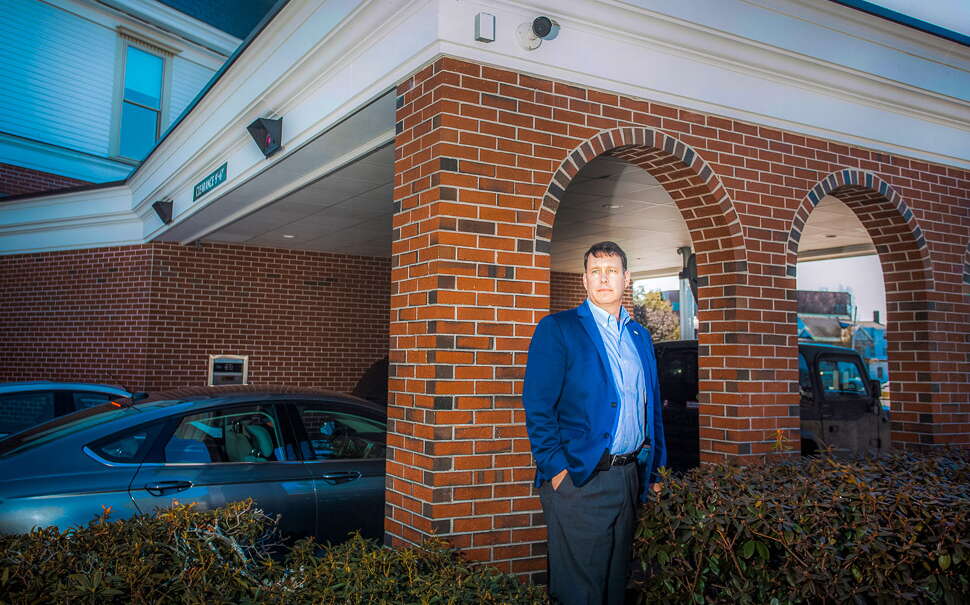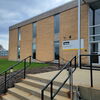
Branching out: In an age of banking apps, institutions grapple with physical footprints
 Photo / Tim Greenway
Neil Kiely, president and CEO of Androscoggin Bank, says two new offices and a consolidation help allocate people and resources while meeting the needs of clients and employees.
Photo / Tim Greenway
Neil Kiely, president and CEO of Androscoggin Bank, says two new offices and a consolidation help allocate people and resources while meeting the needs of clients and employees.
Since October 2023, Lewiston-based Androscoggin Bank has opened a commercial banking office in Portsmouth, N.H., and a business development office in the Piscataquis County town of Guilford.
The expansion into Guilford was a result of collaboration with local officials and businesses that highlighted an unmet need in Piscataquis County for commercial and treasury finance and deposit services, as well as wealth management services.
“Our new Guilford business development office shares space with the Guilford town office and other area economic development groups, making it an ideal area to expand the bank’s footprint and help to create a hub for business development in the area,” says Neil Kiely, president and CEO of Androscoggin Bank.
There will soon be a closure, too. Androscoggin Bank plans to close a retail branch at 12 Subaru Drive in Auburn, due to the close proximity of another retail branch in Auburn less than 3 miles away.
“This consolidation allows us to better allocate our people and resources to ensure we continue to best meet the needs of our clients and employees,” Kiely says.
Competition and opportunities
Like Androscoggin, quite a few banks across Maine are looking to right-size their footprint and leverage market opportunities, with transitions in recent years that include expanded facilities and consolidations.
Bangor Savings opened branches in Boothbay Harbor, Manchester, N.H., Bar Harbor and Kennebunk.
Kennebec Savings opened its southernmost branch.
In 2022, First National opened a Brewer branch and Northeast Bank closed its Buckfield branch. Northeast Bank, headquartered in Lewiston, recently announced its intent to move its Auburn branch within the city.
JPMorgan Chase & Co., which has branches in Falmouth, Portland, Saco, Westbrook and Yarmouth, plans to open in Scarborough later this year. A further southern Maine branch is planned at an undisclosed location.
“Branch openings and closures result from at least two important factors — market opportunities and consolidation,” says Jim Roche, president of the Maine Bankers Association in Westbrook.
“If, for example, a northern Maine bank is looking to better serve existing customers or grow their customer base, then a southern Maine branch may make sense. That helps explain why, for example, 17 banks now serve customers in Portland.”
Altogether, Maine has 29 banks doing business here with 442 offices and $42.75 billion in deposits, according to Federal Deposit Insurance Corp. data through June 30, 2023.
Across those banks, the number of offices — headquarters, branches and operation centers — has remained steady over the past few years.
Roche points out that, even with all the apparent changes in banking, the number of branches in 2022 was 446 and the number in 2021 was 443. “So, the number has remained steady for several years,” he says.
Ongoing evaluations
At Androscoggin Bank, which has $1.54 billion in total assets, the transitions are part of ongoing evaluations of customer needs.
The bank’s Portsmouth expansion responds to existing clients who said a presence there would be helpful. It also provides geographical diversity to help broaden the organization’s market, while remaining close to its Maine-based headquarters, says Kiely.
The new Guilford office is viewed “as an opportunity to deliver banking services in a unique way,” he continues.
Additionally, the bank’s experience has been that the talent pool for experienced and knowledgeable banking employees in the region is strong, enabling Androscoggin to attract and retain employees who can aid clients across the organization’s footprint.
Androscoggin Bank is a certified B Corporation, a designation awarded to businesses that have elected to broaden their mission beyond financial profit to include making a positive impact on society and the environment.
The organization, says Kiely, views the Guilford office as a non-traditional, collaborative approach designed to bring new banking services and business development resources to an underserved market. As such, he says the branch is an example of the B Corp values at work — “being responsive and agile especially when opportunities have a positive effects on our client, community and colleagues.”
Stepping out
Kennebec Savings Bank, founded in 1870 and headquartered in Augusta, has undergone several transitions since 2017.
That was the year the bank opened a branch in Freeport — and it was the first time in the bank’s 150 years that it stepped out of Kennebec County.
Freeport opened initially as a loan production office. It opened as a full-service branch in 2019.
“We had done quite well,” says Andrew Silsby, the bank’s president and CEO.

In 2021, Kennebec Savings — by then with locations in Augusta, Farmingdale, Freeport, Waterville and Winthrop — merged with the similarly named Kennebec Federal Savings, which had two branches, both in Waterville.
The merger resulted in the consolidation of two of the three Waterville branches.
In 2023, Kennebec Savings jumped into the crowded Portland marketplace with a branch at 53 Baxter Blvd. Nearly 15% of the bank’s loan portfolio was already in the Portland area.
The location offers in-person as well as online and mobile services, providing consumer and commercial products and services, and wealth management products.
“In seven months we ended up with $18 million in deposits, so we’ve been quite successful beyond our initial estimates,” says Silsby.
Today, the state-chartered community bank has $1.7 billion in assets and nearly 200 employees.
There are no immediate plans for additional branching.
March to efficiency
Most community banks, says Silsby, “historically have played in our own backyards. But as we have grown larger and need to continue to grow, we are all stepping into each other’s backyard. So, it’s getting highly competitive.”
That could result in more consolidation, he says.
“We’re seeing branch openings but also branch closures,” he says. “It’s about trying to find the right location.”
It’s also about facility and staffing costs.
“You want your branches to be profitable,” Silsby says. “We’re all trying to get more out of less. It’s the march for efficiency.”
Cross-training and improved technology can make it easier to hire fewer employees, each able to handle more roles.
And the pandemic essentially taught many customers that they don’t need face time with a teller to conduct their banking business.
“We’re still down 45% of our foot traffic pre-COVID,” says Silsby.
Many customers got hooked on automated transactions, debit cards, mobile payment services and the like. Silsby cites ATM machines as a declining service.
“We, as a society, are carrying less cash,” he says. “The industry is scratching its head: What does the customer want? We’re all trying to figure out the future of the branch.”
Right location
Bangor Savings Bank has opened four branches in two years. In 2022, it opened a full-service branch in a retrofitted space at 185A Townsend Ave. in Boothbay Harbor.
In 2023, it opened a full-service branch in a new build in Manchester, N.H., followed by a full-service branch, also in a new build, at 112 Cottage St. in Bar Harbor.
This past January, the organization retrofitted a building at 30 Main St. in Kennebunk for its latest full-service branch.
“It’s about making sure you’re in the right location,” says Bob Montgomery-Rice, Bangor Savings’ president and CEO.

What makes the right location? Convenience, ease of access, the right “fit” for the community.
“You don’t want your branch to be hard to get to,” says Montgomery-Rice. When people are out doing errands, “It’s ideal if it’s on the way. It’s got to be easy to park. That’s true of most retail locations regardless of the industry.”
End of the teller line?
Headquartered in Bangor and founded in 1852, Bangor Savings has over $7 billion in assets, 61 branches in Maine and eight in New Hampshire and five business and/or loan production offices in Maine, New Hampshire and Massachusetts.
The branch on Middle Street in Portland’s Old Port is temporarily closed as the building undergoes a major remodeling.
“We’ll reopen that location shortly,” says Montgomery-Rice. “It will be a little bigger, more modern, a little more convenient for customers and a little more private.”
The organization aims to accommodate evolving customer needs. When existing locations are remodeled or new branches are opened, the goal is to offer a more open concept with glass-windowed offices and good sightlines that allow employees to detect and greet customers when they enter the building.
“When a customer comes in, they want to be greeted by somebody pretty quickly and feel it’s warm and inviting,” he says.
With automated banking, long teller lines just don’t exist the way they once did. So branches are built with more of an emphasis on private offices.
“People are coming in less and less to do deposit transactions,” says Montgomery-Rice. “We’ve got technology that lets them do that from their own kitchen table. But when they do come in for advice, they tend to want to be more private. So our branches tend to have less lobby and more offices.”
Branching not only represents the bank’s growth but also drives further growth.
“We had a fair amount of customers in Windham who were driving to our branches in Portland or Auburn,” he says. “We opened a branch in Windham and that took off. It’s now pretty sizable. Usually you develop a critical mass of customers and it grows from there.”















0 Comments